Prevention of Dental Caries: A Review on the Improvements of Toothpaste Formulations from 1900 to 2023
Abstract
1. Introduction
2. Materials and Methods
2.1. Concept and Active Ingredients
2.2. Selection of Patent Database
2.3. Worldwide Patent Search Using Espacenet (1900 to 2023)
2.4. Mintel Search
2.5. Mintel Search Germany Compared with Caries Prevalence in Germany within 1997–2014
2.6. Worldwide Mintel Search—Hydroxyapatite (1996 to 2023)
2.7. Presentation of Data
3. Results
3.1. Number of Worldwide Patent Applications per Decade (1900 to 2019)
3.2. Analysis of Toothpastes Products (1996 to 2023)
3.3. Analysis of Toothpaste Products Containing Hydroxyapatite (1996 to 2023)
3.4. Analysis of Toothpaste Products within the German Market and Comparison with Caries Prevalence (1996 to 2014)
4. Discussion
4.1. Improvement of Toothpaste Formulations from 1900 to 2023—General Considerations
- (A)
- Calcium carbonate
- (B)
- Calcium phosphate
- (C)
- Hydrated silica
- (D)
- Sodium fluoride
- (E)
- Sodium lauryl sulfate
- (F)
- Triclosan
- (G)
- Xylitol
- (H)
- Zinc salts
- General considerations regarding toothpaste abrasives
- Complexity of toothpaste formulations
4.2. Improvement of Toothpaste Formulations from 1900 to 2023—Impact on Caries Decline
4.3. Limitations
4.3.1. Search for Patent Applications
4.3.2. Search for Toothpaste Products
5. Conclusions
Supplementary Materials
Author Contributions
Funding
Data Availability Statement
Acknowledgments
Conflicts of Interest
References
- Van Loveren, C. Toothpastes; Karger: Basel, Switzerland, 2013; ISBN 9783318022063. [Google Scholar]
- Meyer, F.; Schulze zur Wiesche, E.; Bennett, A.T.; Limeback, H.; Enax, J. Caries etiology and preventive measures. Eur. J. Dent. 2024. accepted for publication. [Google Scholar]
- Limeback, H. Comprehensive Preventive Dentistry; John Wiley & Sons, Ltd.: Hoboken, NJ, USA, 2012; ISBN 9781118280201. [Google Scholar]
- Ten Cate, J.M. The need for antibacterial approaches to improve caries control. Adv. Dent. Res. 2009, 21, 8–12. [Google Scholar] [CrossRef]
- Walsh, T.; Worthington, H.V.; Glenny, A.M.; Marinho, V.C.; Jeroncic, A. Fluoride toothpastes of different concentrations for preventing dental caries. Cochrane Database Syst. Rev. 2019, 3, Cd007868. [Google Scholar] [CrossRef]
- Limeback, H.; Enax, J.; Meyer, F. Improving oral health with fluoride-free calcium-phosphate-based biomimetic toothpastes: An update of the clinical evidence. Biomimetics 2023, 8, 331. [Google Scholar] [CrossRef] [PubMed]
- Janakiram, C.; Deepan Kumar, C.V.; Joseph, J. Xylitol in preventing dental caries: A systematic review and meta-analyses. J. Nat. Sci. Biol. Med. 2017, 8, 16–21. [Google Scholar] [CrossRef] [PubMed]
- Enax, J.; Epple, M. Die Charakterisierung von Putzkörpern in Zahnpasten. Dtsch. Zahnärztl. Z. 2018, 73, 116–124. [Google Scholar]
- Marsh, P.D. Contemporary perspective on plaque control. Br. Dent. J. 2012, 212, 601–606. [Google Scholar] [CrossRef]
- Gillam, D.G. Dentine Hypersensitivity: Advances in Diagnosis, Management, and Treatment; Springer International Publishing: Berlin/Heidelberg, Germany, 2015; ISBN 9783319145778. [Google Scholar]
- Joiner, A. Whitening toothpastes: A review of the literature. J. Dent. 2010, 38 (Suppl. S2), e17–e24. [Google Scholar] [CrossRef] [PubMed]
- Fischman, S.L. The history of oral hygiene products: How far have we come in 6000 years? Periodontology 2000 1997, 15, 7–14. [Google Scholar] [CrossRef] [PubMed]
- Lippert, F. An introduction to toothpaste—Its purpose, history and ingredients. Monogr. Oral Sci. 2013, 23, 1–14. [Google Scholar]
- Madhuri, S.V.; Buggapat, L. Dentifrices: An overview from past to present. Int. J. Appl. Dent. Sci. 2017, 3, 352–355. [Google Scholar]
- Segrave, K. America Brushes Up: The Use and Marketing of Toothpaste and Toothbrushes in the Twentieth Century; McFarland & Co: Jefferson, N.C: London, UK, 2010; ISBN 9780786456840. [Google Scholar]
- Lidgey, C.R. Improvements in or Relating to Dentifrices. UK Patent GB191403034A, 5 February 1914. [Google Scholar]
- Adams, S.E.; Arnold, D.; Murphy, B.; Carroll, P.; Green, A.K.; Smith, A.M.; Marsh, P.D.; Chen, T.; Marriott, R.E.; Brading, M.G. A randomised clinical study to determine the effect of a toothpaste containing enzymes and proteins on plaque oral microbiome ecology. Sci. Rep. 2017, 7, 43344. [Google Scholar] [CrossRef] [PubMed]
- Jordan, A.R.; Micheelis, W. Fünfte Deutsche Mundgesundheitsstudie (DMS V); Deutscher Zahnärzte Verlag: Köln, Germany, 2016. [Google Scholar]
- Dorozhkin, S.V.; Epple, M. Biological and medical significance of calcium phosphates. Angew. Chem. Int. Ed. 2002, 41, 3130–3146. [Google Scholar] [CrossRef]
- Harks, I.; Jockel-Schneider, Y.; Schlagenhauf, U.; May, T.W.; Gravemeier, M.; Prior, K.; Petersilka, G.; Ehmke, B. Impact of the daily use of a microcrystal hydroxyapatite dentifrice on de novo plaque formation and clinical/microbiological parameters of periodontal health. A randomized trial. PLoS ONE 2016, 11, e0160142. [Google Scholar] [CrossRef]
- Kim, J.; Lee, S. Patent databases for innovation studies: A comparative analysis of USPTO, EPO, JPO and KIPO. Technol. Forecast. Soc. Chang. 2015, 92, 332–345. [Google Scholar] [CrossRef]
- Marquis, R.E. Antimicrobial actions of fluoride for oral bacteria. Can. J. Microbiol. 1995, 41, 955–964. [Google Scholar] [CrossRef] [PubMed]
- Nayak, P.A.; Nayak, U.A.; Khandelwal, V. The effect of xylitol on dental caries and oral flora. Clin. Cosmet. Investig. Dent. 2014, 6, 89–94. [Google Scholar] [CrossRef]
- Tschoppe, P.; Zandim, D.L.; Martus, P.; Kielbassa, A.M. Enamel and dentine remineralization by nano-hydroxyapatite toothpastes. J. Dent. 2011, 39, 430–437. [Google Scholar] [CrossRef]
- Enax, J.; Amaechi, B.T.; Farah, R.; Liu, J.A.; Schulze zur Wiesche, E.; Meyer, F. Remineralization strategies for teeth with molar incisor hypomineralization (MIH): A literature review. Dent. J. 2023, 11, 80. [Google Scholar] [CrossRef]
- Kensche, A.; Holder, C.; Basche, S.; Tahan, N.; Hannig, C.; Hannig, M. Efficacy of a mouthrinse based on hydroxyapatite to reduce initial bacterial colonisation in situ. Arch. Oral. Biol. 2017, 80, 18–26. [Google Scholar] [CrossRef]
- Wuelknitz, P. Cleaning power and abrasivity of European toothpastes. Adv. Dent. Res. 1997, 11, 576–579. [Google Scholar] [CrossRef]
- Farias, J.O.D.; Almeida do Espírito Santo, J.D.; Aquino Amorim, I.; Berto Rezende, T.M. Triclosan antimicrobial activity against dental-caries-related bacteria. Braz. J. Oral Sci. 2022, 22, e238076. [Google Scholar] [CrossRef]
- Sinicropi, M.S.; Iacopetta, D.; Ceramella, J.; Catalano, A.; Mariconda, A.; Pellegrino, M.; Saturnino, C.; Longo, P.; Aquaro, S. Triclosan: A small molecule with controversial roles. Antibiotics 2022, 11, 735. [Google Scholar] [CrossRef] [PubMed]
- U. S. Food and Drug Administeration. 5 Things to Know about Triclosan. Available online: https://www.fda.gov/consumers/consumer-updates/5-things-know-about-triclosan (accessed on 10 January 2024).
- Burguera-Pascu, M.; Rodríguez-Archilla, A.; Baca, P. Substantivity of zinc salts used as rinsing solutions and their effect on the inhibition of Streptococcus mutans. J. Trace Elem. Med. Biol. 2007, 21, 92–101. [Google Scholar] [CrossRef]
- Brading, M.G.; Marsh, P.D. The oral environment: The challenge for antimicrobials in oral care products. Int. Dent. J. 2003, 53, 353–362. [Google Scholar] [CrossRef] [PubMed]
- Eggert, F.; Neubert, R. In vitro investigation of the liberation of fluoride ions from toothpaste compounds in a permeation model. Eur. J. Pharm. Biopharm. 1999, 47, 169–173. [Google Scholar] [CrossRef] [PubMed]
- Petersson, G.H.; Bratthall, D. The caries decline: A review of reviews. Eur. J. Oral Sci. 1996, 104, 436–443. [Google Scholar] [CrossRef]
- Fejerskov, O.; Kidd, E. Dental Caries: The Disease and Its Clinical Management; Wiley: Hoboken, NJ, USA, 2009; ISBN 9781444309287. [Google Scholar]
- Eden, E. Antimicrobials in caries prevention. Clin. Dent. Rev. 2017, 1, 11. [Google Scholar] [CrossRef][Green Version]
- O’Hagan-Wong, K.; Enax, J.; Meyer, F.; Ganss, B. The use of hydroxyapatite toothpaste to prevent dental caries. Odontology 2022, 110, 223–230. [Google Scholar] [CrossRef]
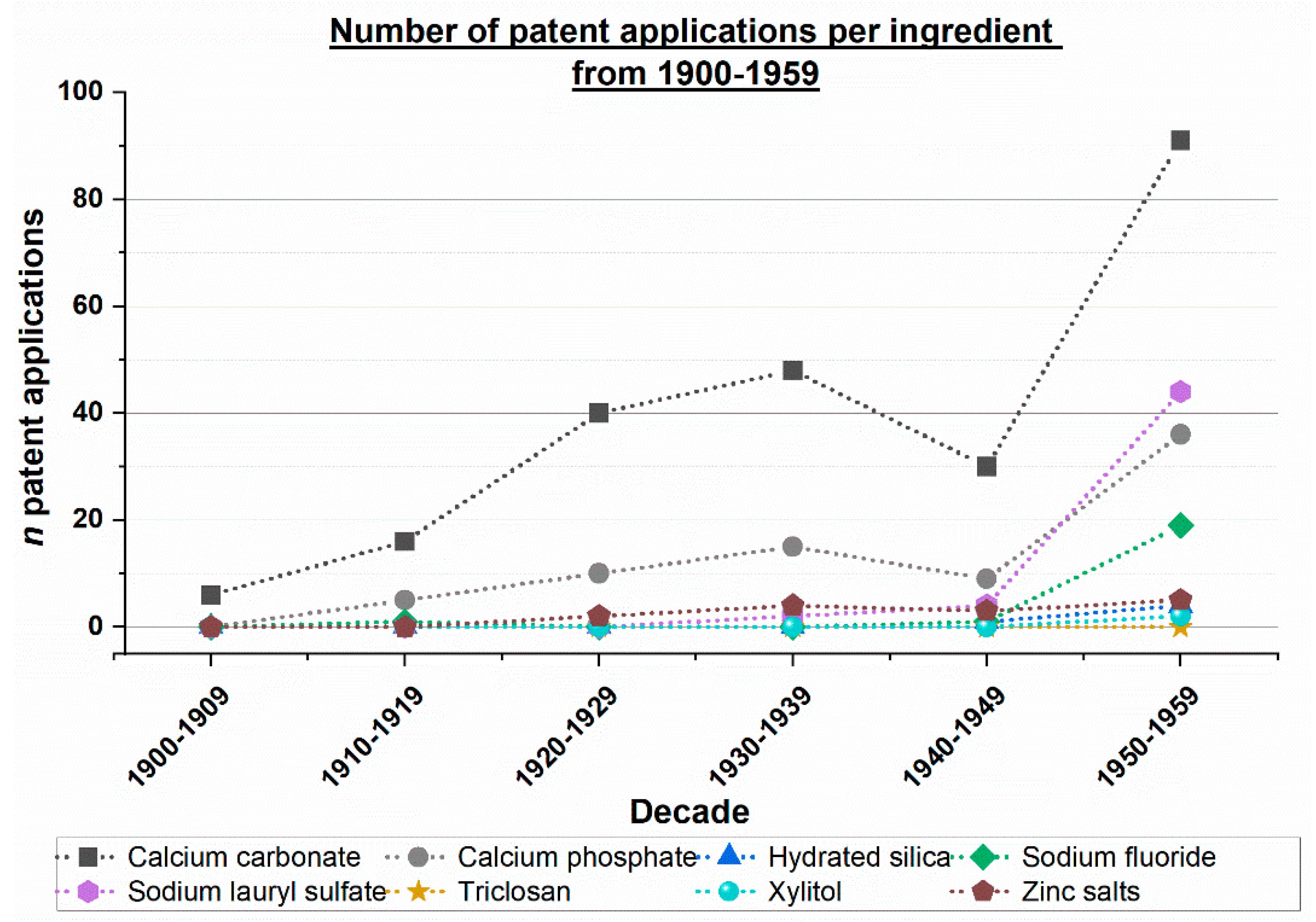
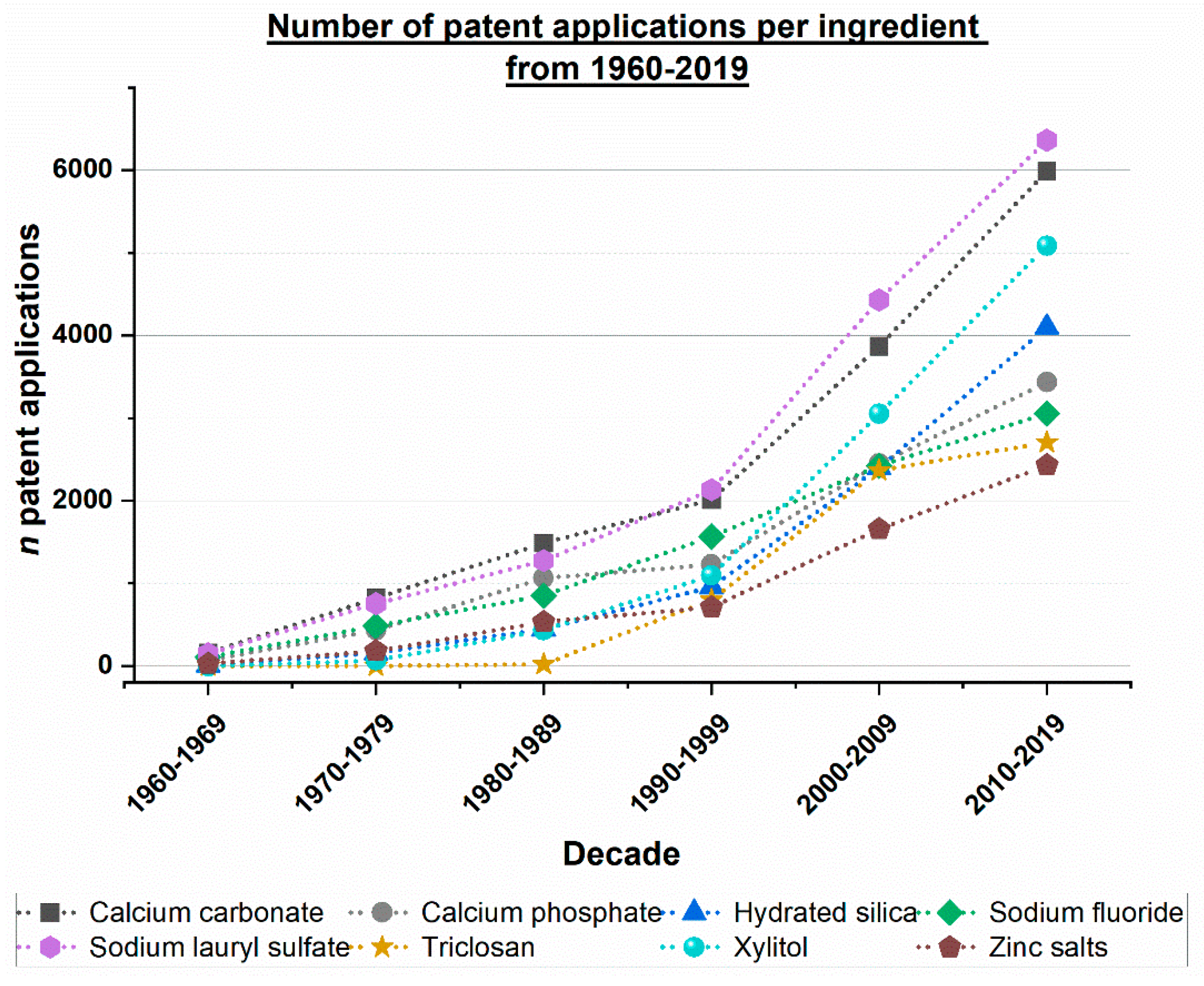

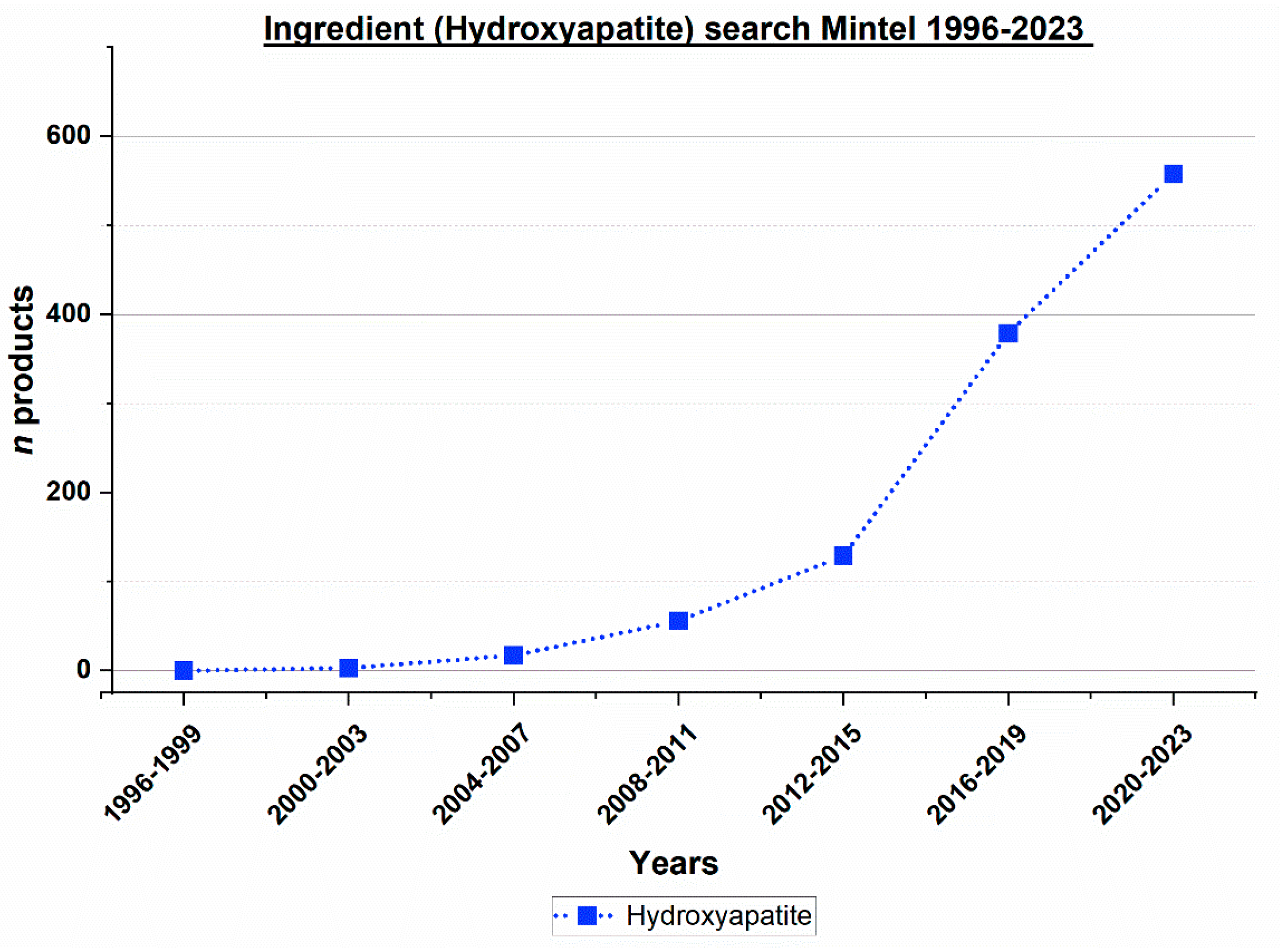
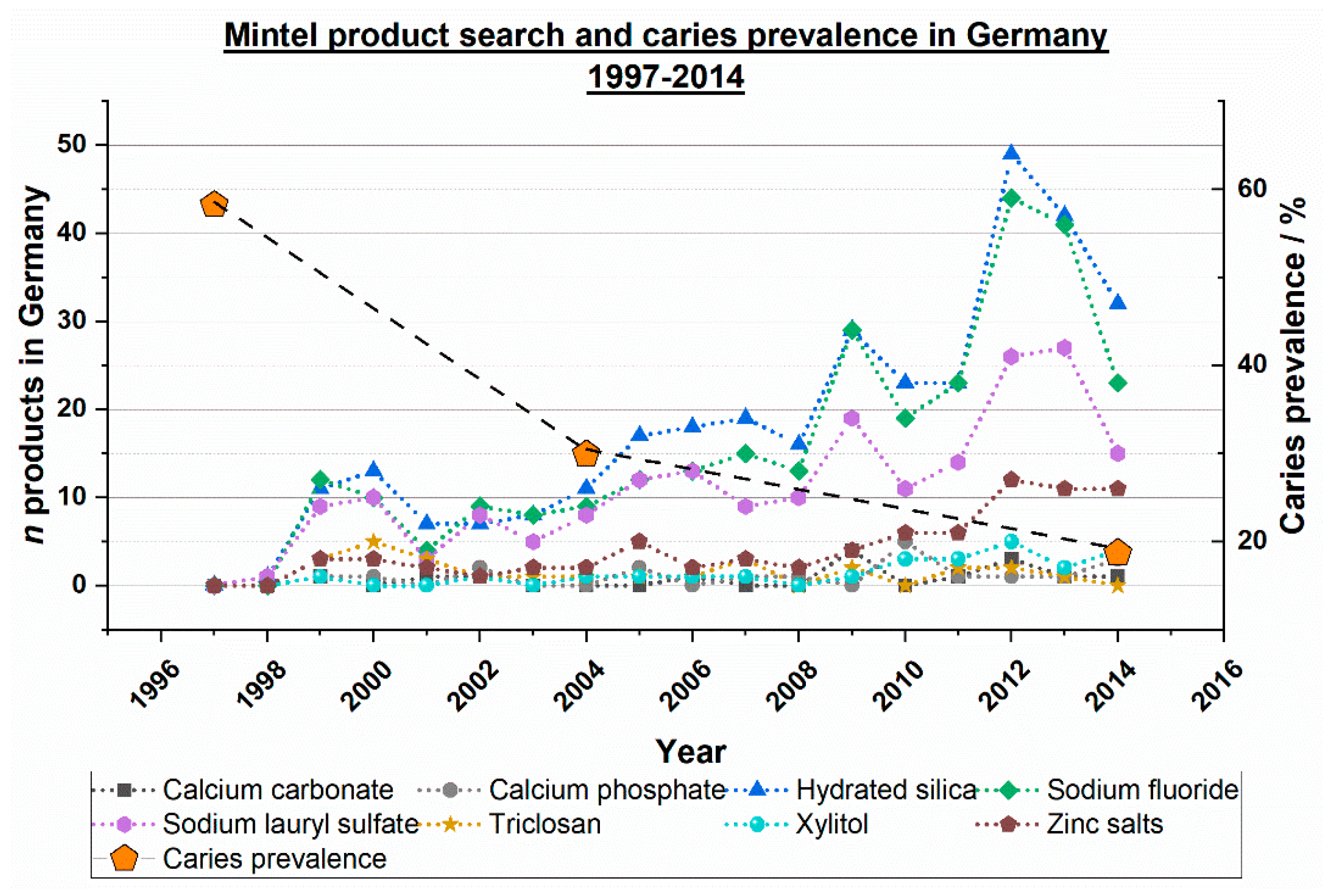
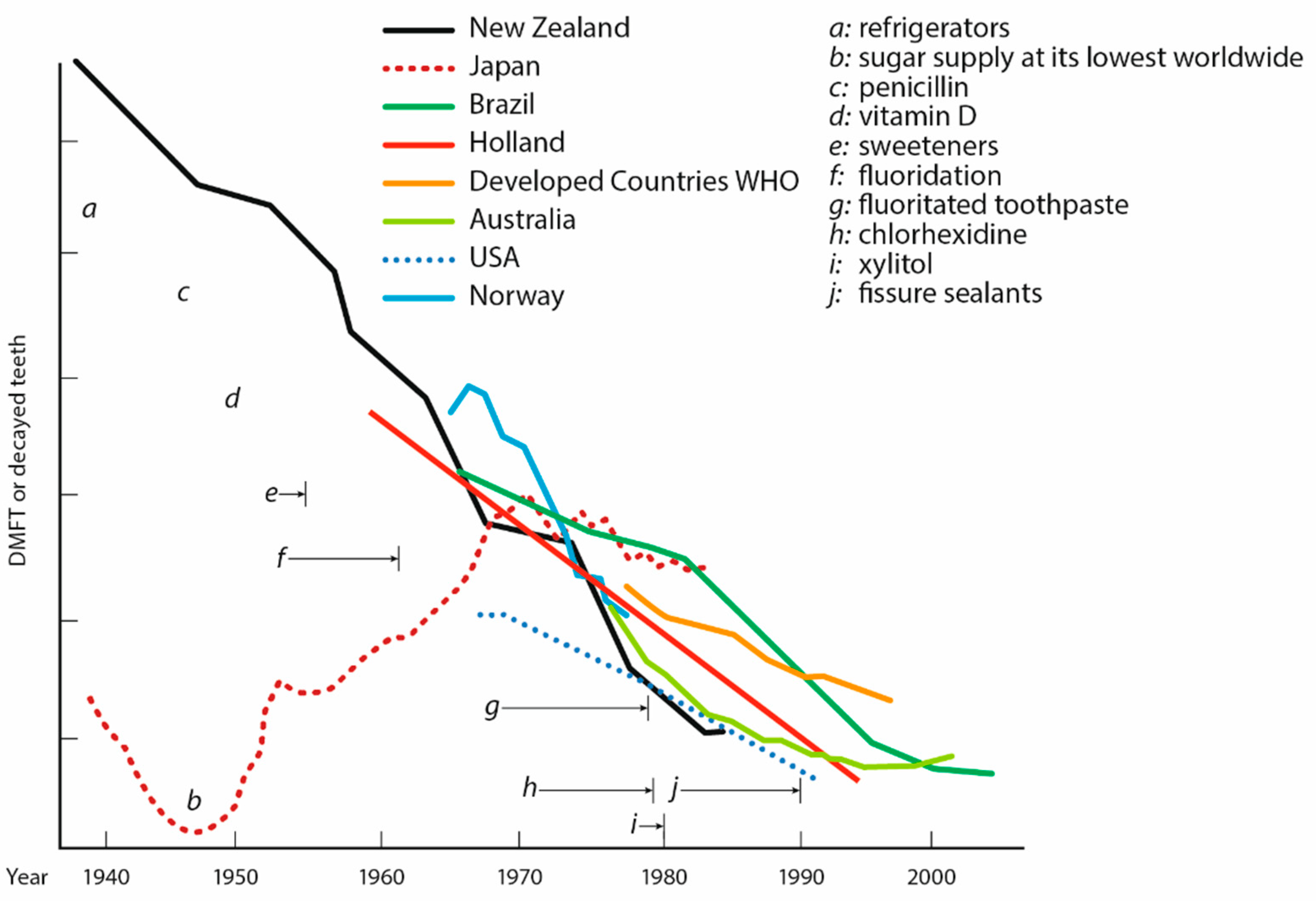
| Ingredient (in Descending Order by Weight Percentage in the Tooth Powder Formulation) | Percentage/wt% |
|---|---|
| Precipitated chalk | 79.0 |
| Florentine orris | 9.9 |
| White castile soap | 4.9 |
| Sugar | 4.9 |
| Oil of wintergreen | 1.2 |
| Ingredient (in Descending Order by Weight Percentage in the Toothpaste Formulation) | Percentage/wt% |
|---|---|
| Calcium fluoride | 40.05 |
| Calcium phosphate | 26.70 |
| Glycerol | 26.70 |
| Potassium chlorate | 2.67 |
| Sodium fluoride | 1.34 |
| Ammonium fluoride | 1.34 |
| Menthol | 0.40 |
| Oil of cinnamon | 0.40 |
| Essence of peppermint | 0.40 |
| Database | Espacenet | Lens | PatentScope | Google Patents | DEPATISnet |
|---|---|---|---|---|---|
| Number of results from 1900 to 2023 | 78,377 | 72,970 | 68,545 | 239,006 | 127,289 |
| Year of earliest patent application | 1854 | 1913 | 1901 | 1923 | 1933 |
| Total Number of Patent Applications Including Toothpaste or Dentifrice | nftxt all “toothpaste” OR nftxt all “dentifrice” |
|---|---|
| Adding ingredient search strings | AND nftxt = “Example ingredient” OR nftxt = “Another example ingredient” |
| Search for each decade (1900 to 2019) | pd within “1900,1909” (etc.) |
| Collect the number of | 1st- total number/2nd- total number + ingredient |
| Ingredients (Alphabetically Ordered) | Synonyms Used in Search |
|---|---|
| Calcium carbonate | “calcium carbonate”, “calcite”, “chalk” |
| Calcium phosphate | “calcium phosphate” |
| Hydrated silica | “hydrated silica”, “precipitated silica”, “silica abrasive”, “silica dental abrasive”, “silicon dioxide”, “zeodent”, “sylodent” |
| Sodium fluoride | “sodium fluoride“ |
| Sodium lauryl sulfate | “sodium lauryl sul*”, “sodium dodecyl sul*”, “SLS”, “SDS”, “sodium laurilsul*” |
| Triclosan | “triclosan”, “irgasan” |
| Xylitol | “xylitol”, “xylit”, “E967” |
| Zinc salts | “zinc acetate”, “zinc chloride”, “zinc glu-conate”, “zinc sul*”, “zinc citrate”, “zinc lactate” |
| Ingredient (Alphabetically Ordered) | Synonyms Used in Mintel Search |
|---|---|
| Calcium carbonate | “calcium carbonate”, “calcite”, “CI 77220” |
| Calcium phosphate | “calcium phosphate”, “dicalcium phosphate”, “dicalcium phosphate dihydrate”, “hydroxyapatite”, “tricalcium phosphate” |
| Hydrated silica | “hydrated silica”, “hydrated silica (Zeodent 113)” |
| Sodium fluoride | “sodium fluoride” |
| SLS | “SLS”, “SDS”, “Sodium lauryl sulfate (SLS)” |
| Triclosan | “triclosan”, “triclosan (irgasan)” |
| Xylitol | “xylitol” |
| Zinc salts | “zinc acetate”, “zinc chloride”, “zinc gluconate”, “zinc sulfate”, “zinc citrate”, “zinc lactate” |
| Surfactant/Period | Cocamidopropyl Betaine | Sodium Myristoyl Sarcosinate | Sodium Methyl Cocoyl Taurate | Sodium Cocoyl Glycinate | Sodium Lauryl Sulfate |
|---|---|---|---|---|---|
| 1900 to 2000 | 90 | 8 | 37 | 0 | 3632 |
| 2001 to 2023 | 966 | 103 | 388 | 155 | 9267 |
| Modes of Action in Caries Prevention | ||||
|---|---|---|---|---|
| Ingredients (Alphabetically Ordered) | Remineralization Effects | Antibacterial Effects | Plaque-Removing Effects | Literature |
| Calcium carbonate | --- | --- | Yes | [8] |
| Calcium phosphates * | Yes | --- | Yes | [6,8] |
| Hydrated silica | --- | --- | Yes | [8] |
| Sodium fluoride | Yes | Yes | --- | [1,22] |
| Sodium lauryl sulfate | --- | Yes | Yes | [1,9] |
| Triclosan | --- | Yes | --- | [9] |
| Xylitol | --- | Yes | --- | [23] |
| Zinc salts | --- | Yes | --- | [9] |
Disclaimer/Publisher’s Note: The statements, opinions and data contained in all publications are solely those of the individual author(s) and contributor(s) and not of MDPI and/or the editor(s). MDPI and/or the editor(s) disclaim responsibility for any injury to people or property resulting from any ideas, methods, instructions or products referred to in the content. |
© 2024 by the authors. Licensee MDPI, Basel, Switzerland. This article is an open access article distributed under the terms and conditions of the Creative Commons Attribution (CC BY) license (https://creativecommons.org/licenses/by/4.0/).
Share and Cite
Unterbrink, P.; Schulze zur Wiesche, E.; Meyer, F.; Fandrich, P.; Amaechi, B.T.; Enax, J. Prevention of Dental Caries: A Review on the Improvements of Toothpaste Formulations from 1900 to 2023. Dent. J. 2024, 12, 64. https://doi.org/10.3390/dj12030064
Unterbrink P, Schulze zur Wiesche E, Meyer F, Fandrich P, Amaechi BT, Enax J. Prevention of Dental Caries: A Review on the Improvements of Toothpaste Formulations from 1900 to 2023. Dentistry Journal. 2024; 12(3):64. https://doi.org/10.3390/dj12030064
Chicago/Turabian StyleUnterbrink, Patrick, Erik Schulze zur Wiesche, Frederic Meyer, Pascal Fandrich, Bennett T. Amaechi, and Joachim Enax. 2024. "Prevention of Dental Caries: A Review on the Improvements of Toothpaste Formulations from 1900 to 2023" Dentistry Journal 12, no. 3: 64. https://doi.org/10.3390/dj12030064
APA StyleUnterbrink, P., Schulze zur Wiesche, E., Meyer, F., Fandrich, P., Amaechi, B. T., & Enax, J. (2024). Prevention of Dental Caries: A Review on the Improvements of Toothpaste Formulations from 1900 to 2023. Dentistry Journal, 12(3), 64. https://doi.org/10.3390/dj12030064






